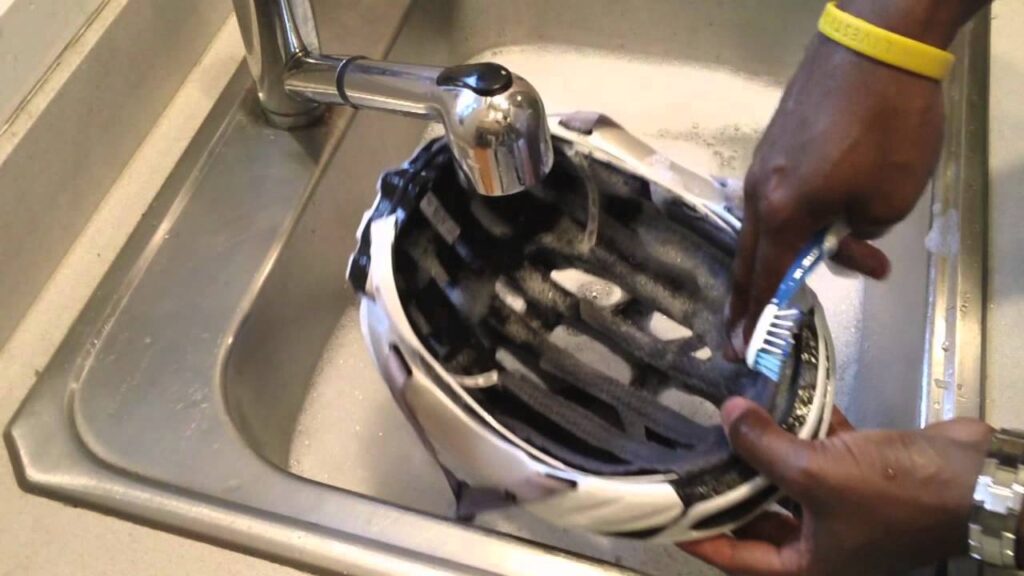To clean a bike helmet, remove the pads and wash them with mild soap. Wipe the helmet with a damp cloth.
A clean bike helmet ensures safety and hygiene. Sweat, dirt, and grime can accumulate over time, leading to unpleasant odors and potential skin issues. Proper cleaning maintains the helmet’s integrity and extends its lifespan. Start by removing the interior pads and washing them separately with mild soap.
Use a damp cloth to gently wipe the helmet’s outer shell and inner lining. Avoid harsh chemicals that can damage the materials. Air-dry all components thoroughly before reassembling. Regular cleaning keeps your helmet fresh and ready for every ride. This simple maintenance routine can enhance your riding experience and ensure optimal performance.
Materials Needed
Cleaning your bike helmet is essential for maintaining its durability and hygiene. Before you start, gather all the necessary materials. Having everything in one place makes the process easier and more efficient.
Essential Supplies
To clean your bike helmet, you need some essential supplies. These items are crucial for a thorough and effective cleaning.
- Mild Soap: Use a gentle soap to avoid damage.
- Soft Cloth: A microfiber cloth is ideal for cleaning.
- Warm Water: Helps to remove grime and dirt.
- Soft-bristled Brush: Useful for scrubbing hard-to-reach areas.
Optional Add-ons
Consider these optional add-ons for a more comprehensive cleaning. They can enhance your cleaning routine but are not strictly necessary.
- Helmet Cleaner Spray: Specially formulated for helmets.
- Disinfectant Wipes: For a quick and easy disinfecting.
- Odor Eliminator: Helps to keep your helmet smelling fresh.

Credit: www.cyclist.co.uk
Preparation
Cleaning your bike helmet is essential for safety and hygiene. Proper preparation makes the process smooth and effective. In this section, we will guide you through setting up your work area and performing a helmet inspection.
Setting Up Work Area
First, choose a clean and spacious area. This can be a garage or backyard.
- Ensure the area has good lighting.
- Lay down old newspapers to catch drips.
- Have a bucket of warm water ready.
- Gather cleaning supplies: mild soap, sponge, and a soft brush.
Make sure everything is within reach to avoid interruptions.
Helmet Inspection
Inspect your helmet for any damage before cleaning.
- Check the outer shell for cracks or dents.
- Inspect the inner foam for signs of wear.
- Look at the straps for any fraying or damage.
- Ensure the padding is intact and not deteriorating.
Identifying any issues early can help you decide if the helmet needs repair or replacement. If you find severe damage, it might be time for a new helmet.
Removing Helmet Pads
Cleaning your bike helmet is essential for hygiene and longevity. One of the crucial steps is removing helmet pads. This ensures a thorough clean and maintains the helmet’s comfort.
Detaching Pads
First, find out how the pads are attached. Most helmets use Velcro or snap buttons.
- Carefully pull the pads away from the helmet shell.
- Start from one end and gently work your way around.
- Be cautious to avoid damaging the pads or the helmet.
Once removed, inspect the pads for any wear or damage. Replace any worn-out pads to ensure maximum safety and comfort.
Cleaning Pads
Fill a bowl with lukewarm water and mild soap. Avoid harsh chemicals.
- Submerge the pads in the soapy water.
- Gently scrub them with a soft brush or your hands.
- Rinse thoroughly under clean water to remove soap residue.
Place the cleaned pads on a towel. Allow them to air dry completely before reattaching.
Avoid direct sunlight or heat sources, which can damage the pads.
Cleaning The Shell
Keeping your bike helmet clean is essential for safety and hygiene. The helmet shell protects your head and should be maintained. Follow these steps to clean the shell effectively.
Washing Exterior
First, gather your cleaning materials. You will need:
- Mild soap
- Soft cloth or sponge
- Warm water
Begin by removing any loose dirt. Use a soft cloth or sponge and warm water. Add a few drops of mild soap to the water. Gently scrub the helmet shell.
Rinse the helmet with clean water. Make sure all soap is removed. Wipe the helmet dry with a soft towel. Let it air dry completely before use.
Tackling Tough Stains
Sometimes, tough stains need extra attention. For these, you will need:
- Baking soda
- Water
- Soft brush
Mix baking soda with water to form a paste. Apply the paste to the tough stains. Use a soft brush to scrub the stains gently.
Rinse the helmet with clean water again. Ensure all baking soda residue is removed. Dry the helmet with a soft towel. Allow it to air dry fully.
For very stubborn stains, repeat the process. Never use harsh chemicals. They can damage the helmet shell.
Cleaning The Straps
Keeping your bike helmet straps clean is crucial. Dirty straps can cause skin irritation and smell bad. Let’s explore how to clean your helmet straps effectively.
Soaking Straps
First, prepare a bowl of warm soapy water. Use mild soap to avoid any damage. Detach the straps from the helmet if possible.
Next, submerge the straps in the water. Let them soak for 15-20 minutes. This helps loosen dirt and grime.
Scrubbing And Rinsing
After soaking, take a soft brush. A toothbrush works well. Gently scrub the straps to remove any remaining dirt.
Rinse the straps under cold water. Make sure all soap is washed away. Squeeze excess water out of the straps.
Leave the straps to air dry completely. Avoid direct sunlight to prevent damage.
| Step | Action | Tip |
|---|---|---|
| 1 | Prepare soapy water | Use mild soap |
| 2 | Soak the straps | Let soak for 15-20 minutes |
| 3 | Scrub the straps | Use a toothbrush |
| 4 | Rinse thoroughly | Ensure all soap is removed |
| 5 | Air dry the straps | Avoid direct sunlight |

Credit: www.instructables.com
Reassembling The Helmet
After cleaning your bike helmet, the next step is reassembly. This process ensures your helmet is ready for use and safe. Follow these steps to ensure a proper reassembly.
Reattaching Pads
First, gather all the pads you removed during cleaning. Make sure they are completely dry. Wet pads can lead to mold and odors.
Attach the pads back to their original positions inside the helmet. Most pads have Velcro strips for easy attachment. Press them firmly to make sure they stick well.
Refer to the user manual if you are unsure about pad placement. Proper pad positioning ensures comfort and safety.
Final Inspection
Once the pads are reattached, perform a final inspection of the helmet. Look for any signs of wear or damage. Small cracks can compromise safety.
Check the straps and buckles for wear. Ensure they are secure and functional. Replace any damaged parts immediately.
Verify the fit by wearing the helmet. Adjust the straps if needed. A well-fitted helmet is crucial for protection.
| Checklist | Action |
|---|---|
| Pads | Reattach and ensure they are dry |
| Straps | Check for wear and adjust fit |
| Buckles | Ensure they are secure |
| Helmet Shell | Inspect for cracks or damage |
Following these steps ensures your bike helmet is ready for your next ride. A properly reassembled helmet provides maximum safety and comfort.
Drying And Storage
Proper drying and storage are crucial for maintaining your bike helmet’s longevity. After cleaning, ensure your helmet is dry and stored correctly. This prevents odor, mold, and damage.
Air Drying
After washing your helmet, air drying is the best method. Avoid direct sunlight, as UV rays can weaken the helmet’s material. Follow these steps:
- Place the helmet in a well-ventilated area.
- Ensure all parts are separated for thorough drying.
- Use a fan to speed up the drying process.
Never use a dryer, as the heat can damage the helmet’s components.
Proper Storage
Storing your helmet properly ensures it stays in good condition. Follow these guidelines:
- Choose a cool, dry place: Avoid damp areas to prevent mold.
- Avoid direct sunlight: Keep it away from UV rays.
- Use a helmet bag: Store it in a protective bag to prevent scratches.
- Keep it away from chemicals: Avoid storing near chemicals or solvents.
| Do | Don’t |
|---|---|
| Use a fan for drying | Expose to direct sunlight |
| Store in a cool, dry place | Store near chemicals |
| Use a helmet bag | Use a dryer |
By following these steps, your bike helmet will remain clean, dry, and ready for your next ride. Proper maintenance ensures your helmet’s longevity and safety.
Maintenance Tips
Keeping your bike helmet clean ensures it lasts longer and remains safe. Following a regular maintenance routine helps maintain its quality and hygiene. Here are some key tips to keep your helmet in top condition.
Regular Cleaning Schedule
Establishing a regular cleaning schedule is essential for maintaining your helmet. Aim to clean it after every few rides. Use mild soap and water to gently wash the outer shell. Avoid harsh chemicals that can damage the helmet’s material.
- Remove the padding and straps before cleaning.
- Use a soft cloth or sponge for cleaning.
- Rinse thoroughly with clean water.
- Allow it to air dry completely before reassembling.
Handling Sweat And Odor
Bike helmets can accumulate sweat and odor over time. Addressing these issues promptly can help maintain hygiene.
| Issue | Solution |
|---|---|
| Excessive Sweat | Use helmet liners to absorb sweat. Wash liners regularly. |
| Unpleasant Odor | Sprinkle baking soda inside the helmet. Leave overnight, then brush out. |
For persistent odors, consider using a helmet deodorizer. Avoid using strong fragrances that can irritate your skin.
By following these maintenance tips, you can ensure your bike helmet remains clean, fresh, and safe for every ride.

Credit: www.youtube.com
Frequently Asked Questions
How Often Should You Clean A Bike Helmet?
Clean your bike helmet after every few rides or once a month. Regular cleaning prevents grime buildup and keeps it hygienic.
What Supplies Do You Need To Clean A Helmet?
You need mild soap, water, a soft cloth, and a toothbrush. Avoid using harsh chemicals or abrasive materials.
Can You Put A Bike Helmet In The Dishwasher?
No, do not put your bike helmet in the dishwasher. High heat and detergents can damage the helmet’s materials.
How Do You Remove Sweat Stains From A Helmet?
Use a soft cloth with mild soap and water. Gently scrub the stained areas, then rinse and air dry.
Conclusion
Keeping your bike helmet clean ensures safety and longevity. Regular maintenance prevents bacteria buildup and keeps it fresh. Follow these simple steps for a spotless helmet. Enjoy your rides with a clean, comfortable helmet, and stay safe on the road.
Cleaning your helmet is quick, easy, and highly beneficial.


